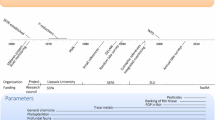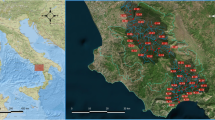Abstract
Water quality data collected in periodic monitoring programs are often difficult to evaluate, especially if the number of parameters is large, the sampling schedule varies, and values are of different orders of magnitude. The Scatterscore Water Quality Evaluation was developed to yield a quantitative score, based on all measured variables in periodic water quality reports, indicating positive, negative or random change. This new methodology calculates a reconnaissance score based on the differences between up-gradient (control) versus down-gradient (treatment) water quality data sets. All parameters measured over a period of time at two or more sampling points are compared. The relationship between the ranges of measured values and the ratio of the medians for each parameter produces a data point that falls into one of four sections on a scattergram. The number and average values of positive, negative and random change points is used to calculate a Scatterscore that indicates the magnitude and direction of overall change in water quality. The Scatterscore Water Quality Evaluation, a reconnaissance method to track general changes, has been applied to 20 sites at which coal utilization by-products (CUB) were used to control acid mine drainage (AMD).
Similar content being viewed by others
References
ACAA: 2003, ‘American Coal Ash Association 2002 Coal Combustion Product (CCP) Production and Use Survey’, Retrieved from http://www.ACAA-USA.org.
Ackman, T. E., Jones, J. R. and Kim, A. G.: 1996, ‘Water quality changes at three reclaimed mine sites related to the injection of coal combustion residues’, in: 13th Annual Pittsburgh Coal Conference, University of Pittsburgh, Pittsburgh, PA, USA, pp. 1055–1060.
Brown, R. M., McClell, N. I., Deininger, R. A. and Tozer, R. G.: 1970, ‘A Water quality index: Do we dare?’, Water Sewerage Works 117, 339–343.
Dixon, W. and Chiswell, B.: 1996, ‘Review of aquatic monitoring program design’, Water Res. 30(9), 1935–1948.
DOE: 1994, ‘U.S. Department of Energy. Barriers to the Increased Utilization of Coal Combustion/Desulfurization By-Products by Government and Commercial Sectors’, Report to Congress, DOE Office of Fossil Energy.
EPA: 1996, ‘Environmental Indicators of Water Quality in the United States’, Office of Water, EPA-841-R-96-002, 30 pp.
EPA: 2000, ‘Environmental Protection Agency’, Center for Exposure Assessment Modeling. http://www.epa.gov/ceampubl, December 5, 2000.
EPA: 2002, ‘Index of Watershed Indicators’, http://www.epa.gov/iwi January 14, 2002.
Fetter, C. W.: 1994, Applied Hydrogeology, 3rd ed., Prentice-Hall, pp. 421–426.
Hawkins, J. W., Ackman, T. E. and Aljoe, W. W.: 1991, ‘The effect of grout injection on mine spoil groundwater hydrology’, in: Presented at the National Meeting of the American Society for Surface Mining and Reclamation, 14–17 May 1991, Durango, CO.
Hirsch, R. M., Slack, J. R. and Smith, R. A.: 1982, ‘Techniques of trend analysis for monthly water quality data’, Water Resources Res. 18(1), 107–120.
Hsu, J. C.: 1996, ‘Multiple comparisons’, Theory Methods, Chapman & Hall, London, 277 pp.
Khan, F., Husain, T. and Lumb, A.: 2003, ‘Water quality evaluation and trend analysis in selected watersheds of the Atlantic Region of Canada’, Environ. Monitor. Assess. 88, 221–242.
Kim, A. G. and Ackman, T. E.: 1994, ‘Disposing of coal combustion residues in inactive surface mines: Effects on water quality’, in: Proceedings of the International Land Reclamation and Mine Drainage Conference, 1994, BuMines Special Publication, SP06D-94, Vol. 4, pp. 228–236.
Kim, A. G. and Cardone, C. R.: 1997a, ‘Coal ash placement in surface mines: Preliminary statistical analysis of water quality data’, in: Proceedings of the 19 Annual Conference of the Association of Abandoned Mine Lands Program, 17–20 Auguast 1997, Davis, W. VA, Section III, pp. 1–9.
Kim, A. G. and Cardone, C. R.: 1997b, ‘Preliminary statistical analysis of fly ash disposal in mined areas’, in: Proceedings of the 12th International Symposium on Coal Combustion By-Product Management and Use, Vol. 1, American Coal Ash Association, pp. 11-1–11-13.
Kim, A. G., Kazonich, G. and Dahlberg, M.: 2003, ‘Solubility of cations in Class F Fly Ash’, Environ. Sci. Technol. 37(19), 4507–4511.
Loftis, J. C., MacDonald, L. H., Street, S., Iyer, H. K. and Bunte, K.: 2001, ‘Detecting cumulative watershed effects: The statistical power of pairing’, J. Hydrol. 251, 49–64.
PADEP: 1993, ‘Pennsylvania Department of Environmental Protection’, Module 25: Placement of Coal Ash at Surface Mining Activities, ER-MR-311, 18 pp.
Pesce, S. F. and Wunderlin, D. A.: 2000, ‘Use of water quality indices to verify the impact of Cordoba City (Argentina) on the Suqua River’, Water Res. 34(11), 2915–2926.
Saaty, T. L.: 1980, The Analytic Hierarchy Process, McGraw-Hill, New York.
Sargaonkar, A. and Deshpande, V.: 2003, ‘Development of an overall index of pollution for surface water based on a general classification scheme in Indian context’, Environ. Monitor. Assess. 89, 43–67.
Stambuk-Giljanovic, N.: 1999, ‘Water quality evaluation by index in Dalmatia’, Water Res. 33(16), 3423–3440.
Yeung, I. M. H.: 1999, ‘Multivariate analysis of the Hong Kong Victoria Harbour water quality data’, Environ. Monitor. Assess. 59, 331–342.
Author information
Authors and Affiliations
Corresponding author
Rights and permissions
About this article
Cite this article
Kim, A.G., Cardone, C.R. Scatterscore: A Reconnaissance Method To Evaluate Changes In Water Quality. Environ Monit Assess 111, 277–295 (2005). https://doi.org/10.1007/s10661-005-8225-2
Received:
Accepted:
Issue Date:
DOI: https://doi.org/10.1007/s10661-005-8225-2




